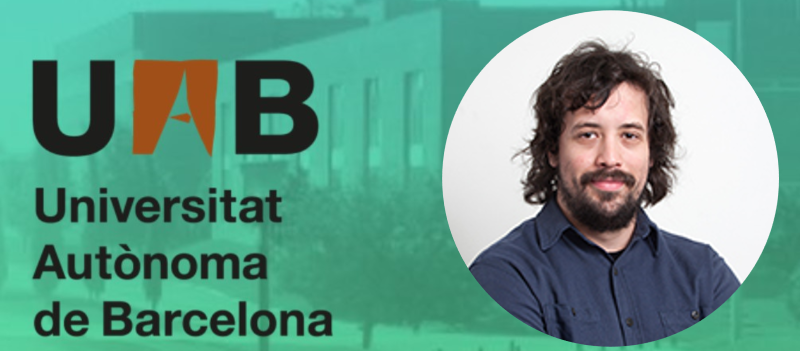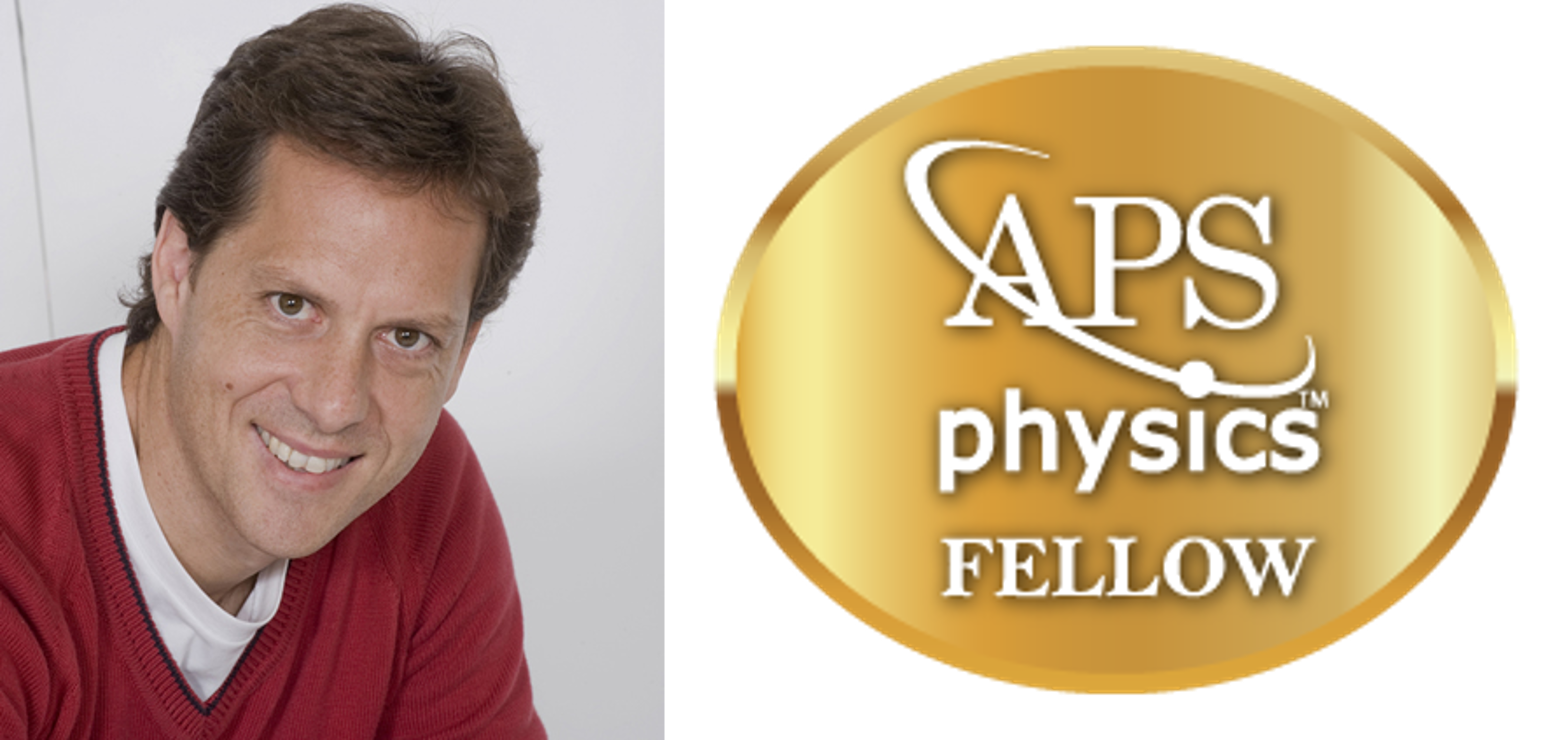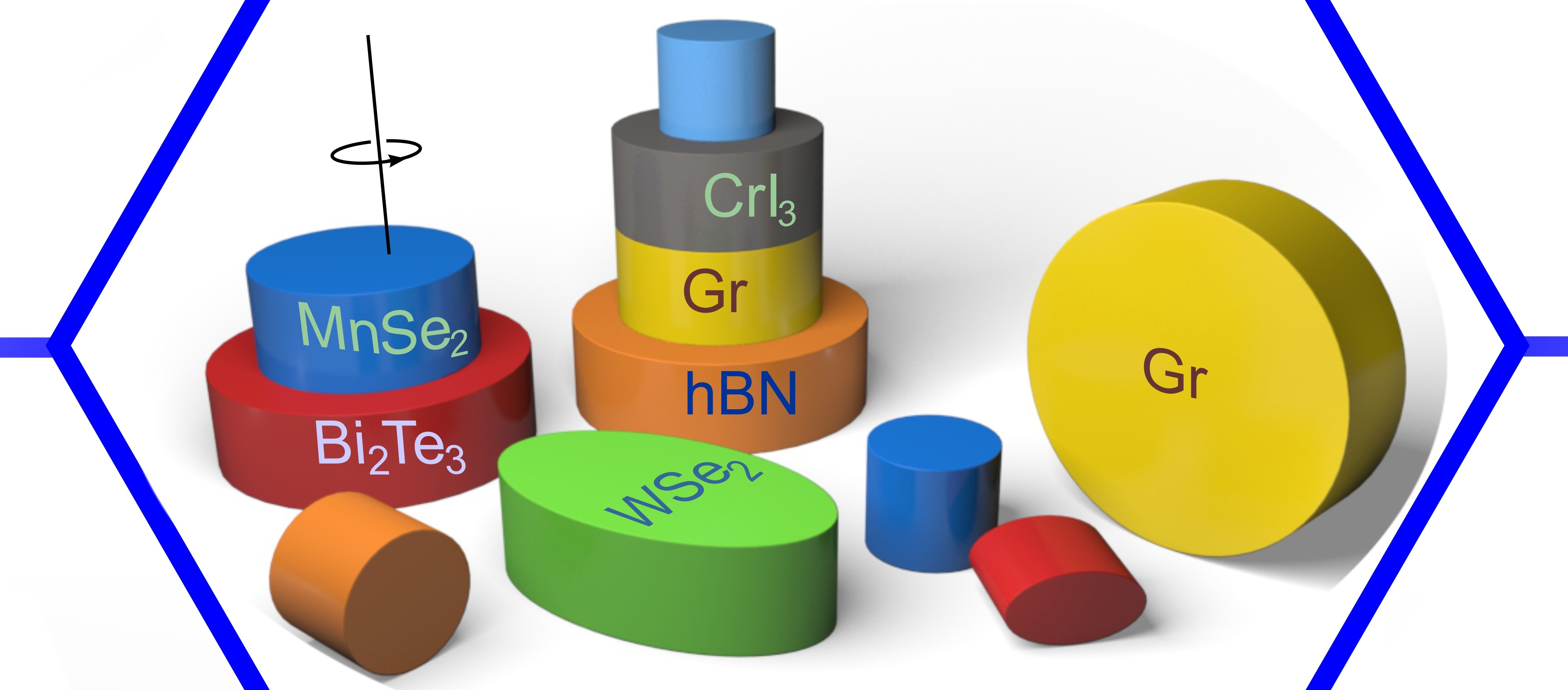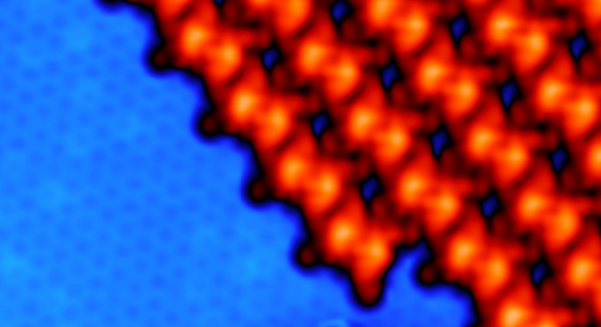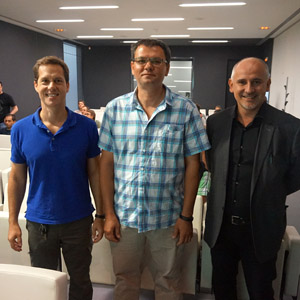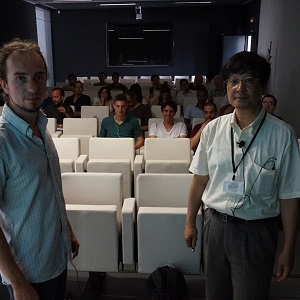News
During his doctoral studies at the ICN2, within the groups led by Prof. Dr Clivia Sotomayor-Torres and Prof. Sergio Valenzuela respectively, Dr Colombano Sosa worked on the high-precision measurement of magnetic fields and synchronization in optomechanical cavities.
This research provides key insights into how the surface states of topological insulators, a special class of quantum materials, change due to the introduction of magnetic impurities. The findings of this study could significantly advance the field of spintronics and potentially pave the way for future breakthroughs in electronics technology.
A paper recently published in 'Light: Science & Applications’ demonstrates that quantum materials of the topological insulator family can efficiently upconvert electromagnetic radiation in the terahertz (THz) regime. These results open new avenues for THz photonics technology and its application in sensing, homeland security and sixth-generation mobile communications. The study was conducted by a team of researchers coordinated by ICN2 group leader Dr Klaas-Jan Tielrooij.
This Fellowship is assigned to APS members who have distinguished themselves by making important contributions to physics.
An introduction to the quantum materials research and the equipment used at the ICN2 was provided to the students of this year’s edition of the MQST by a few of our researchers. ICREA Prof. Stephan Roche, group leader at the ICN2 and a member of the Master’s Coordination Team, was the host of this meeting and guided tour.
A review published last week in "Nature" highlights the extraordinary opportunities provided by two-dimensional (2D) materials for the development of next-generation non-volatile memories, based on spintronic mechanisms. Faster, low-power-consumption and high-capability memories are required to support the skyrocketing diffusion of smart devices and the Internet of Things. This work was coordinated by ICN2 group leaders and ICREA professors Stephan Roche and Sergio O. Valenzuela, and by Prof. Hyunsoo Yang from the National University of Singapore. It was carried out in collaboration with research centres and industrial partners in Europe and Asia, within the framework of the EU Graphene Flagship project.
After the enthusiastic reception of the first edition (Bilbao, 2021), this second appointment of the Quantum Matter Conference renews its success with great participation by representatives of academia, research and industry. The ICN2 is among the organisers of the event.
The event, held on March 7 at the ICN2, consisted of a series of presentations by female scientists awarded in previous years’ editions of the Women Talent Programme, a round table on the effectiveness of special tools for the promotions of women’s career in science and technology, and finally the ceremony of the 2021 Awards.
The study reveals the thermal transport properties of ultrathin crystals of molybdenum diselenide.
A study published in “Advanced Materials” reveals the thermal transport properties of ultrathin crystals of molybdenum diselenide, a two-dimensional material of the transition metal dichalcogenide (TMD) family. Outperforming silicon, TMD materials prove to be outstanding candidates for electronic and optoelectronic applications, such as flexible and wearable devices. This research, which involved researchers belonging to four ICN2 groups and from ICFO (Barcelona), Utrecht University (the Netherlands), the University of Liège (Belgium) and the Weizmann Institute of Science (Israel), was coordinated by ICN2 group leader Dr Klaas-Jan Tielrooij.
Former PhD student at the ICN2, in the Physics and Engineering of Nanodevices Group.
His theoretical study on spin dynamics in 2D quantum materials, developed within the ICN2 Theoretical and Computational Nanoscience Group, will be published in the Springer Theses series.
Almost twenty years after its discovery, graphene keeps surprising researchers. Prof. Luis Foà Torres and Prof. Sergio O. Valenzuela discuss an unclear phenomenon observed in graphene on the pages of “Physics World”.
In a review just published in Nature Nanotechnology, the recent progress and enormous potential of van der Waals heterostructures are highlighted. These artificial materials, made up of layers of different 2D crystals, can be designed to exhibit specific functionalities to be harnessed in spintronic and opto-spintronic devices.
The first edition of a new conference dedicated to topological quantum system was held between June 28 and July 1, 2021.
The ICN2 is involved in a series of initiatives to support this day to raise awareness of the persistent gender gap un the world of research. Some ICN2 women researchers will participate in “100tífiques” to bring science and the role of women in Science closer to young students.
A review published today in IOP’s Journal of Physics: Materials draws an outline of the state of the art of quantum materials science and identifies the main challenges and opportunities in this emerging field of research. The paper is a work developed in collaboration by many international experts, including ICN2 researchers from the Theoretical and Computational Nanoscience group and the Physics and Engineering of Nanodevices group. ICN2 group leader Prof. Stephan Roche is co-corresponding author.
A study conducted by a team of researchers from the ICN2, in collaboration with colleagues from ALBA Synchrotron Light Source (Spain) and Diamond Light Source (United Kingdom), has found absence of magnetic proximity effects at the interface of heterojunctions made of a topological insulator and a magnetic insulator. These results are highly relevant to clear up the discrepancy between the experimental and theoretical analysis of these systems, as they were obtained using a direct experimental probe of locally induced magnetism, in contrast to previous experimental works.
A team of researchers led by members of the ICN2 Photonic and Phononic Nanostructures group and the Physics and Engineering of Nanodevices group has designed a novel type of magnetic field sensor – i.e. a magnetometer – characterized by high-sensitivity and fast response.
A group of scientists from the ICN2 Physics and Engineering of Nanodevices Group and Osaka University have demonstrated that intermixing in heterostructures plays a critical role in the generation of spin-orbit torques. Inserting a suitable normal metal spacer, material intermixing is reduced and the topological insulator properties at the interface are largely improved. The work is published in Nano Letters.
A kick-off event finishing today summarises the next steps to be taken by the work package led by ICREA Prof. Stephan Roche into Core 3, the new phase of the Graphene Flagship designed to advance toward the commercialisation of graphene and layered materials. The event served to introduce new companies and new challenges that will boost graphene-enabled spintronic technologies to higher technology readiness levels.
The visit of two young journalists last February has resulted in a video describing BrainCom and a story on the TOCHA project. The first project works on brain-computer interfaces to restore the ability to speak and the second works on the next generation of electronic, photonic and phononic devices. Those are European projects led by the ICN2, but the visit also involved researchers from ICMAB.
A project aiming at developing large-scale integrable devices for application in quantum computing, proposed by ICREA Prof. Sergio Valenzuela and MIT Prof. William Oliver, will be funded through the MIT-Spain “la Caixa” Foundation Seed Fund Programme. The 12 selected projects have been announced on April 20.
Controlling the interactions at the interface of a magnetic/topological insulator heterostructure is an outstanding challenge with implications in fundamental science and technology. A research led by the ICN2 Atomic Manipulation and Spectroscopy Group and the Physics and Engineering of Nanodevices Group, in collaboration with the Supramolecular Nanochemistry and Materials Group, the CFM-San Sebastián, ETH Zurich, ISM-Trieste and ALBA Synchrotron, has shown that ligands from metal-organic molecules can be used to tailor the properties of these interfaces. The results are presented in ACS Nano.
On the occasion of the International Women’s Day, on March 9 the ICN2 hosted an event to discuss about gender balance in research and present the Equal Opportunities and Diversity Management Plan II, which was launched in 2019 and will extend up to 2022.
The ICN2 Physics and Engineering of Nanodevices group, led by ICREA Prof. Sergio O. Valenzuela, has been assigned an ERC Proof of Concept grant to develop novel scalable ultrafast non-volatile memories. The names of the grantees of the 2019 Round Three were announced on January 10.
27 High School students will interact during 16 work sessions with researchers from all the participating excellence centers offering exciting experiences that explore the biggest and the smallest scales of the universe. Coordinated from the ICN2 and the IFAE, Crazy for Physics (Bojos per la Física) also involves the UAB, the ICMAB, the ICFO, the ICE, the UB and the Alba Synchrotron.
ICN2 researchers, in the framework of the Graphene Flagship, demonstrate that spin currents can be generated and manipulated in graphene-based heterostructures at room temperature. The results of this study, published in Nature Materials, provide relevant information on the fundamental physics of the phenomena involved and open the door to new applications, such as the development of ultra-compact electronic and low energy consumption devices and magnetic memories.
Researchers of the ICN2 Physics and Engineering of Nanodevices group and of the NanoBiosensors and Byoanalitical Applications group showed Oschmann around and presented him some research developed in our centre’s laboratories.
The IFAE and the ICN2 have coordinated the fourth edition of the Crazy for Physics oprogramme promoted by the Fundació Catalunya La Pedrera. A selected group of highly skilled undergraduate students have enjoyed a series of experiences at excellence research centers.
Researchers from the ICN2 Physics and Engineering of Nanodevices Group have proposed a modified graphene-based nanodevice fabrication technique that has increased up to three times the spin lifetime and relaxation length compared to previous work of the same kind. The work was fruit of the collaboration with Imec and K.U. Leuven (Belgium). The results have been published in 2D Materials and are expected to empower investigations on large-scale spintronic applications.
The winners of the “la Caixa” fellowshios were announced in a ceremony held on Friday 12 July at CosmoCaixa Barcelona. Iván Fernández Aguirre develops his PhD studies performing research on 2D new materials (as Graphene and Topological Insulators) at the ICN2 Physics and Engineering of Nanodevices Group, led by ICREA Prof. Sergio O. Valenzuela.
Starting this morning in Rome, this edition of the Graphene Conference series (June 25-28) will bring together experts on graphene and 2D materials from around Europe, as well as companies interested in exploiting new promising technologies in this field. The ICN2 has a leading role in creating new graphene-based scientific and industrial opportunities. Visit the BIST booth we share with our colleagues from ICFO and IFAE!
The event, held on 8-9 May, is the first of a series of workshops offering an overview of the different research areas covered by the ICN2 Severo Ochoa Strategic Plan. It was focused on ultrafast dynamics and organised in collaboration with the European centre of excellence MaX, GRR-I Graphene&Co and GDR Graphene&Co. ICREA Prof. Stephan Roche, Group Leader of the ICN2 Theoretical and Computational Nanoscience Group, was the local coordinator of the event.
Since April 1, the ICN2 has become an official partner of King Abdullah University of Science and Technology (KAUST) to work on a research program on spin-orbitronics. ICREA Professors S. Roche and S. O. Valenzuela will be involved in this project during the next three years.
Together with a test to predict response to immunotherapy drugs against cancer and a research on the origins of autism, the nanoporous graphene has been awarded today at La Pedrera with this recognition promoted by La Vanguardia and Fundació Catalunya La Pedrera. The ICN2 researchers from the Atomic Manipulation and Spectroscopy Group led the research published in Science together with DIPC, CiQUS and other ICN2 researchers.
Nanoporous graphene earned the third prize just after a test to predict response to immunotherapy drugs against cancer and a research on the origins of autism. ICREA Prof. Aitor Mugarza and Dr César Moreno, from the ICN2 Atomic Manipulation and Spectroscopy Group, led the research published in Science together with DIPC, CiQUS and other ICN2 researchers.
The ICN2 is involved in a series of initiatives to support this Day that is unfortunately still necessary. 100tífiques is one of the central actions involving the ICN2, the BIST centers and other Catalan research institutions to bring science and the role of women researchers closer to young students.
The European Project TOCHA, launched today through a kick-off meeting in Barcelona, proposes radically new technologies taking advantage of the unique properties of topological matter that can prove crucial for information processing, quantum communication and metrology. TOCHA is funded with 5 Million Euros for the next five years and is coordinated by the ICN2.
La Vanguardia has selected the “nanoporous graphene” among the candidates to win its prestigious award Vanguardia de la Ciencia. The research describing the synthesis of a graphene membrane with pores whose size, shape and density can be tuned with atomic precision was published in Science by the ICN2 Group led by the ICREA Prof. Aitor Mugarza together with other ICN2 members, the CiQUS and the DIPC. The winner will be one of the 8 candidates that will be selected through popular vote.
25 High School students will interact during 16 work sessions with researchers from all the participating excellence centers offering exciting experiences that explore the biggest and the smallest scales of the universe. Coordinated from the ICN2 and the IFAE, Crazy for Physics (Bojos per la Física) also involves the UAB, the ICMAB, the ICFO and the Alba Synchrotron.
The 3rd edition of the Crazy for Physics programme, funded by the Fundació Catalunya / La Pedrera and coordinated by the ICN2 and IFAE, ended at Món Natura Pirineus with a weekend devoted to science and the future perspectives of the participants. Some 25 outstanding high school students enjoyed a year of theoretical and practical experiences at some of the best Catalan research centres.
ICN2 researchers were involved in a number of dissemination activities held during Science Week (9-18 November 2018). The figure of Richard Feynman and science aimed at young girls were the theme of some of the events in which the ICN2 participated during this intense week.
The event brought together a wide representation of the BIST postdoc community in a lively event at CosmoCaixa.
This researcher combines the study of fundamental physics with applied research, exploring ultrafast dynamics in nanoscale systems and their application in the fields of photodetection, quantum technologies and telecommunications. Building on close collaborations via inter-institutional projects within BIST, he will join the ICN2 in October as junior group leader, complete with his recently awarded ERC Starting Grant.
The UAB organised a meeting of researchers involved in the P-Sphere Cofund project to encourage synergies and collaborations. Up to 6 Postdoctoral Researchers from the ICN2 are part of this exciting initiative.
ICREA professors Sergio O. Valenzuela and Stephan Roche discuss the recent Nature Electronics paper by Konstantin Novoselov, Abhishek Misra and colleagues in the context of future spin-based memory technologies.
The journal just published a news item detailing the advance led by ICN2 researchers from the ICN2 Atomic Manipulation and Spectroscopy Group in the context of a a national research collaboration. The results were originally published in Sciece with Dr César Moreno and ICREA Prof. Aitor Mugarza as first and last authors, respectively.
Graphene 2018 is being held in Dresden (Germany) from 26 to 29 June 2018. ICN2 is there once again with organisational, institutional and scientific efforts to share the latest advances in graphene research. Drop by the ICN2 booth to learn about brain implants to restore speech or nanoporous graphene, among other breakthroughs.
A recent work led by the ICN2 is featured in this prestigious magazine for its significance in the field of electronics. The groundbreaking production of an atomically precise nanoporous graphene complete with energy bandgap is the result of a collaboration between the ICN2, CiQUS and DIPC.
Over 20 schools participated in the latest NanoEduca video and poster contest. At the awards ceremony, set up to mimic a real-life science conference, Dr. Adriana Isabel Figueroa García talked about what motivated her to get into research.
As part of a national research collaboration, Spanish researchers including the ICN2 have made uniformly nanoporous graphene a practicable reality. A major milestone in graphene research, this brings us one step closer to unlocking this wonder material’s full potential not only in electronics, but also in filtration and sensing applications. Presented this morning to journalists at a press conference at the Barcelona Institute of Science and Technology, the work is published in Science.
Lab tours give young students the opportunity to interact with real scientists and get a sense of what happens at a research centre. Last week almost 100 students came through our doors to learn about the research carried out at the ICN2. This event was made possible thanks to the participation of the researchers and admin personnel who gave up some their time to organise some unique experiences.
Today the Barcelona Institute of Science and Technology (BIST) announce the five projects that will receive seed funding under the 2018 edition of its Ignite programme to accelerate multidisciplinary research at its member institutes.
A recent article from the Graphene Flagship outlines how the strong collaborative ethos of this largescale European research initiative is accelerating developments in new graphene-based technologies. Among the featured papers are two by ICN2 group leaders ICREA Prof. Stephan Roche and ICREA Prof. Sergio O. Valenzuela.
Experimentalists of the ICN2 Physics and Engineering of Nanodevices Group, led by ICREA Prof. Sergio O. Valenzuela, have found evidence that the spin-orbit coupling induced in graphene by proximity to transition metal dichalcogenides affects electron spins differently depending on their orientation. Published in Nature Physics, this work suggests new approaches to controlling the transport of spin and valley information in future spintronics devices.
ICN2 researchers have demonstrated that the application of a thermal gradient in spintronic devices can cause spin signal to increase as a result of a novel thermoelectric phenomenon predicted and subsequently observed in graphene. Specifically, the enhanced spin signal is two orders of magnitude larger than anything previously reported for thermal effects in metals. Published in Nature Nanotechnology, these findings push at the frontier of graphene spintronics technologies.
The ICN2 and the Taiwanese National Center for Theoretical Sciences (NCTS) are coordinating the first joint Taiwan-Spain workshop on "2D Materials and Interfaces for Spintronics". It will take place on the UAB Campus, just outside the city of Barcelona, from 23 to 25 October 2017. Register today to join the conversation on the rapidly-evolving field of 2D material and interfaces for spintronics.
ICREA Prof. Stephan Roche and ICREA Prof. Sergio Valenzuela, Group Leaders at ICN2, in collaboration with researchers from Delaware University and CEA have recently published an article in Physical Review Letters. They question the interpretation of large values from the Spin Hall effect (SHE) signals, reported experimentally in chemically decorated graphene. Further, they propose new device geometry to suppress background contributions on the non-local resistance to access the upper limit of SHE in two-dimensional materials.
CSIC honored researchers who had been awarded in 2015 with a high impact award. Over 100 CSIC-related researchers gathered during a ceremony held in the CSIC Central Headquarters in Madrid. The Spanish Secretary of State for Research, Development and Innovation, Carmen Vela, presided over the event together with CSIC’s President, Emilio Lora-Tamayo.
The Graphene Flagship includes a Spintronics Work Package exploring the ultimate potential of graphene and two-dimensional materials for spintronic applications. The next revolution will come when using spin for processing information in computers. The participants of this initiative are meeting on May 24 and 25 at the Bellaterra Campus of the Universitat Autònoma de Barcelona (UAB), in an event organised by ICREA Research Prof. Stephan Roche, Group Leader at ICN2 and Deputy Leader of the Spintronics Work Package. This will be the first joint meeting between the Flagship consortium and representatives of the 5 projects related to spintronics selected in the first call of the FLAG-ERA partnership.
An article published today in Nature Communications presents a new method to determine the spin lifetime anisotropy of spin-polarized carriers in graphene using oblique spin precession. The work, led by ICREA research Prof Sergio O Valenzuela, Group Leader of the ICN2 Physics and Engineering Of Nanodevices Group, demonstrates spin-lifetime anisotropy measurements in graphene and discusses them in light of current theoretical knowledge.
In November 2015 Prof Albert Fert visited ICN2. We had the opportunity to interview him and record his ICN2 Manuel Cardona Lecture entitled "Spin-orbitronics, a new direction for spintronics". Interacting with him is a gift for curious minds. Now you can watch on YouTube both his highly specialised talk and a relaxed interview. We hope you enjoy it!
ICREA Prof Sergio O. Valenzuela, Group Leader at ICN2, is among the 5 authors of a review article highlighted on the cover of the journal Reviews of Modern Physics. The article offers a pedagogical overview of the Spin Hall effect, both from a theoretical and from an experimental perspective.
The Nobel Prize awardee and member of the ICN2 Scientific Advisory Board offered on November 11, 2015, a Manuel Cardona Lecture entitled “Spin-orbitronics, a new direction for spintronics”. Afterwards he participated in a tour through the ICN2 involving different Groups and a lively discussion during a friendly lunch.
“What can topological insulators do for spintronics?”. It is the appealing title of the talk offered today at ICN2 by Prof Branislav K. Nikoliã, and introduced by the ICN2 Group Leaders Prof Stephan Roche and Prof Sergio O. Valenzuela.
El Mundo Innovadores has interviewed Dr Marius V. Cotache, ICN2 Ramon y Cajal Researcher, for his recent award, the Young Scientist Medal in the field of Magnetism, granted by the International Union of Pure and Applied Physics. The good news has also appeared in the online channel Phys.org.
Prof Yoshishige Suzuki, from the Osaka University (Japan), visited ICN2 after taking part in the International Conference on Magnetism celebrated in Barcelona. Dr. Frédéric Bonell, Postdoctoral Researcher at the Physics and Engineering of Nanodevices Group, worked with him before arriving ICN2 and presented the Seminar.
The IUPAP Young Scientist Medal is the most prestigious award received by a young researcher working on magnetism. The award recognises the original experiments performed by Dr Marius V. Costache related with spin pumping and the magnon-drag effect. He will give an invited lecture after receiving the Medal during the 20th International Conference on Magnetism held in Barcelona.
ICREA Professors Sergio O. Valenzuela, Stephan Roche and Arben Merkoci are guest-editors of two Focus Issues about spintronics and nanobiosensors respectively, published by 2D Materials.
In a new article published in Nano Letters, ICN2 researchers led by ICREA Prof Sergio O. Valenzuela have investigated hot carrier propagation across graphene using an electrical nonlocal injection/detection method. The results create new opportunities for nanoscale bolometry and calorimetry and could have a strong impact in the performance of conventional graphene devices.
ICN2 Prof Stephan Roche and Prof Sergio Valenzuela, together with Dr Frank Ortmann, are the co-authors of a new book about topological insulators which describes the key principles and the main techniques used to study these materials. The book has been published by Wiley VCH.
After visiting the ICN2, Prof Konstantin Novoselov offered on May the 27th a talk at the UAB Science Faculty in the framework of the Manuel Cardona Conferences. Over 300 people attended the event and shared a very interesting presentation by the 2010 Nobel Prize in Physics winner.
Students of the Radboud University, from the Netherlands, visited the ICN2 during a trip around the main Spanish research centres related with Physics. They had the opportunity to visit some of the laboratories and speak with the researchers about their work at the Institute.
Within the framework of Manuel Cardona Conferences, Luigi Colombo recently came to the ICN2 to offer a talk about 2D materials growth, invited by Prof Stephan Roche. He also visited some of the laboratories of the institute and he talked to us in an exclusive interview conducted by Sebastian Grinschpun.
The new equipment allows the manufacturing of topological insulators, among other materials, and the possibility to study their properties when submitted to different conditions. The installation of the MBE also means a new way of collaboration among ICN2 Groups thanks to the new Severo Ochoa positions.
Members of ICN2 Theoretical and Computational Nanoscience Group unveil an unprecedented spin relaxation mechanism unique to graphene, and related with entanglement of spin and pseudospin quantum degrees of freedom in presence of weak spin-orbit coupling effects. This phenomenon revisits years of controversies and opens a new window into the challenge of manipulating spin degree of freedom in future information-processing technologies.
The Session gathered experts from around Europe in the areas of Biosensors, Theory, ICT and Energy. It was an opportunity to celebrate the Severo Ochoa accreditation in the context of a first-line international event.
Four ICN2 Group Leaders will introduce the main research areas of the Severo Ochoa Program related with ICT, Energy, Biosensors and Theory. Four Keynote speakers will give their point of view on each research area.
The new book offers a comprehensive review of the state-of-the-art in innovative Beyond-CMOS nanodevices, including the results of NANOFUNCTION Network of Excellence. Members from the teams led by ICREA Research Professor Clivia Sotomayor and ICREA Research Professor Sergio O. Valenzuela are among its authors.
Dr. Ali Afshar Farinya, Dr. Ingmar Neumann, and Dr. Marta Rubio successfully defended their Theses in the last few weeks.
Prof. Valenzuela offers today a talk about Topological Insulators at the International Nanotechnology Conference on Communication and Cooperation.
Physical Review Letters published the first study to show the impact of optical phonons on electron transport in topological insulators. This study, led by Dr. Marius V. Costache and ICREA Prof. Sergio O. Valenzuela of the ICN2 Physics and Engineering of Nanodevices Group, explores the limitations of transport in these unique materials.
The Network of Excellence (NoE) "Beyond CMOS nano-devices for adding functionalities to CMOS" (NANOFUNCTION), which includes two ICN2 Groups, has been selected as one of the Top Stories of the European Commission which highlight the achievements of success stories of the Seventh Framework Programme.
ICREA Research Professor Sergio O. Valenzuela has just won a European Research Council (ERC) Starting Grant, the fourth to have been awarded to an ICN researcher.
Prof Valenzuela’s winning project deals with topological insulators, a fascinating new class of materials with unique electronic behavior.
Professors Stephan Roche and Sergio O. Valenzuela are the featured speakers at today’s 49th ICREA Colloquium, entitled "Materials for Revolutionary Applications in Everything".
Dr Roche will discuss the state-of-the-art in graphene research, and Dr Valenzuela, will cover the fledgling area of topological insulators. The Colloquium, held in Barcelona, begins at 6 pm.
A 50-year quest to isolate the thermoelectric effect is now over
As electrons move past atoms in a solid, their charge distorts the nearby lattice and can create a wave. Reciprocally, a wave in the lattice affects the electrons motion, in analogy to a wave in the sea that pushes a surfer riding it. This interaction results in a thermoelectric effect that was first observed during the 1950´s and has come to be known as phonon-drag, because it can be quantified from the flow of lattice-wave quanta (phonons) that occurs over the temperature gradient. Soon after the discovery of the phonon drag, an analogous phenomenon was predicted to appear in magnetic materials: the so called magnon drag. In a magnetic material the intrinsic magnetic moment or spin of the electrons arrange in an organized fashion. In ferromagnets, the spins maintain a parallel orientation. If a distortion in the preferred spin orientation occurs, a spin wave is created that could affect electron motion. It is therefore reasonable to expect that the flow of magnons (spin-wave quanta) could also drag the electrons. Despite the similarities with phonon drag, the observation of the magnon drag has been elusive, and only a few indirect indications of its existence have been reported over the years. The main reason being the presence of other thermoelectric effects, most notably the phonon drag, that make it difficult to discriminate its contribution to the thermopower. Researchers of ICN´s Physics and Engineering of Nanodevices Group, Marius V. Costache, German Bridoux, Ingmar Neumann and group leader ICREA and UAB Prof. Sergio O. Valenzuela, used a unique device geometry to discriminate the magnon drag from other thermoelectric effects. As reported in the journal Nature Materials, the device resembles a thermopile formed by a large number of pairs of ferromagnetic wires placed between a hot and a cold source and connected thermally in parallel and electrically in series. By controlling the relative orientation of the magnetization in pairs of wires, the magnon drag can be studied independently of the electron and phonon drag thermoelectric effects. The work is very timely as thermoelectric effects in spin-electronics (spintronics) are gathering increasing attention as a means of managing heat in nanoscale structures and of controlling spin information by using heat flow. Measurements as a function of temperature reveal the effect on magnon drag following a variation of magnon and phonon populations. This information is crucial to understand the physics of thermal spin transport. It both provides invaluable opportunities to gather knowledge about electron-magnon interactions and may be beneficial for energy conversion applications and for the search of novel pathways towards transporting spin information.
ICN researchers pave the way for spin computers. A “Spin Ratchet”, a new electronic structure for generating spin current, is demonstrated for the first time.
Researchers of the Institut Catala de Nanotecnologia (ICN), in Barcelona, have demonstrated a device that induces electron spin motion without net electric currents, a key step in developing the spin computers of the future.
